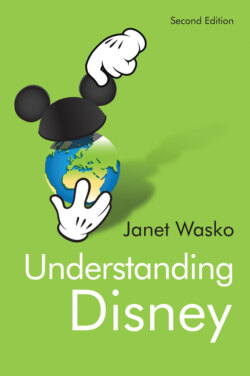Читать книгу Understanding Disney - Janet Wasko - Страница 9
From universe to multiverse
ОглавлениеIn 1973, in his book Mass-Mediated Culture, Michael Real described the Walt Disney Company as the “Disney universe.”1 He argued that the term was appropriate because: (1) the Disney organization used it; (2) it signified the “universality” of Disney’s products; and (3) the Disney message created “an identifiable universe of semantic meaning.” Following Real’s lead in the previous edition of Understanding Disney, the concept of the Disney universe was defined as “the company, its parks, products, and policies, the individuals who manage and work for the company, as well as Disney characters and images, and the meanings they have for audiences.”
But, as noted above, the Disney company has expanded dramatically since 2000, becoming one of the largest and most dominant media and entertainment corporations in the world. The company has added several key companies and franchises that also have become known as universes – Pixar, Marvel, Lucasfilm, and 21st Century Fox. These are now owned by the Disney corporation, which has become greater than just one universe. We can now refer to something called the “Disney Multiverse.”
The definition of “multiverse” refers to many universes or, more specifically, “a hypothetical collection of potentially diverse observable universes.” Though scientists are not all convinced of the actual existence of multiverses, it is a concept that is often used as a metaphor.
The notion of a Disney Multiverse has received some attention from fans who explore overlapping films and worlds, game designers who have created a few Disney Multiverse games, and so on. The company itself has provided examples of their multiverse, for instance at their theme parks, and most recently in the film, Ralph Breaks the Internet. But, as in the Marvel and Star Wars universes, these examples relate only to narrative universes, or in other words, focus on locations, time periods, stories, and characters from films, television programs, books, and so on.
In this discussion, the Disney Multiverse refers to the totality of Disney, not merely its various narrative universes. It includes all of the previously mentioned components of the Disney corporation – its corporate management, directors, shareholders, and employees; its corporate ethos, policies, and strategies; its divisions, products, services, and properties; its content, values, and meanings; and its audiences, consumers, and fans; as well as the other universes that it owns (Pixar, Marvel, Lucasfilm, and 21st Century Fox) (see Figure 1.2). Not only are we interested in how these universes are different – with their own products, characters, narratives, etc. – but also important are the ways in which they are controlled by the Disney corporation and influenced by its policies and strategies, as well as how these universes may connect/interact as part of the Disney Multiverse. More details about these components and their relationships will be explored in this volume as we seek to understand this immense, multifaceted, and significant entity.
Figure 1.2: The Disney Multiverse
Interestingly, a 2009 episode of the Fox-distributed satirical television show Family Guy was called “Road to the Multiverse.” In the program, Stewie and Brian travel by time machine and at one point visit the “Disney universe,” where they find the characters, dialogue, songs, and settings to be very obviously “Disney-like.”2 In this edition of Understanding Disney, we will be exploring the road to the Disney Multiverse.
